• September 9, 2011 •
Each of us has an ideal recipe for what makes a fine hunting dog. The ingredients include some combination of good companionship, natural hunting drive, and versatility.
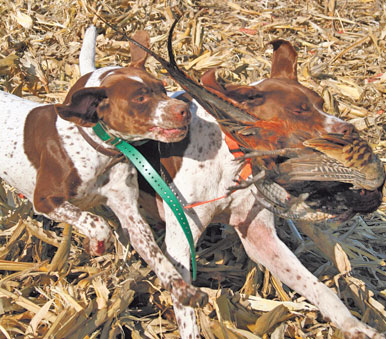
Savvy and Cleo eagerly retrieve a South Dakota rooster. Braque Francais are natural retrievers, something rather unique among most of the pointing breeds.
While the French are known for their haute recipes and fine cuisine, they have also given us some fine gun dogs. The Brittany comes to mind. But another great pointing dog hails from France, and continues to gain a paw-hold in North America — the Braque Francais, or French Pointer.
I met these wonderful dogs on a pheasant hunt with Brad Boisen ofSouth Dakota’s Grand Ciel Lodge. I learned firsthand that Boisen’s description of these lovely white-and-brown pointing dogs — “calm, quiet and easy-going family dogs that become hunting demons in the field” — was right on.
The Braque Francais combines a laid-back and loving disposition with an eagerness to please and a fierce drive to hunt. If you’re looking for a versatile hunting dog that will love you, be part of the family, require minimal training and hunt up a storm, consider the Braque. It would be hard to cook up a better dog.
HISTORY
Like all short-haired pointing breeds, the Braque Francais originated in Europe. The ancestor of today’s Braque — a big, burly, hound-like canine known as oysel — developed on the Mediterranean flanks of the Pyrenees Mountains in what is now France, Spain and Italy. This dog was more suited to “rough shooting,” as hunting’s goal was game on the table (feathered or furred), not elegant dog work.
Like all short-haired pointing breeds, the Braque Francais originated in Europe. The ancestor of today’s Braque — a big, burly, hound-like canine known as oysel — developed on the Mediterranean flanks of the Pyrenees Mountains in what is now France, Spain and Italy. This dog was more suited to “rough shooting,” as hunting’s goal was game on the table (feathered or furred), not elegant dog work.
Jacques Espee de Selincourt, a huntsman for the French royalty, wrote of the Braque in his 1683 book La Parfait Chasseur (The Perfect Hunter): “He is a quite tall dog, very strong, with a robust chest, big head, long ears, good-sized nose, loose lips, and a white coat with brown spots.” This basic description serves any of today’s short-haired pointing breeds, because they all originated from this stock.
After the French revolution in 1789, the landscape changed. With less wild land (and smaller parcels) to hunt, a big and wide-ranging dog was a liability. This is when the Braque Francais/Pyrenees — a smaller, calmer and closer-working dog — was bred.
Most peasant folk didn’t own firearms. If you did, you might not want to shoot them while poaching on your lord’s land. So a close-working Braque would point and hold the birds (often partridge), you’d cast a net to catch them, then skedaddle home. There, you had a smaller, calmer, affectionate and mild-mannered companion to share your cottage. But the dog kept its innate hunting drive and desire. It was the perfect recipe, one that we can value today.
The old-style, larger dog survived in the Gascogne region of France, and is known as the Braque Francais / Gascony or Biscay. Dr. C. Castets, first president of the Club du Braque Francais, worked to preserve this dwindling variety. M.B. Senac-Lagrange, the club’s second president, fancied the smaller Pyrenees type, which exists in better numbers today and is the dog we’re discussing here.
IMMIGRATION
The first North American to bring Braques to these shores was Michel Gelinas of Quebec, in 1973. “Dogs I imported from France were carefully selected from top French breeders who [were] anxious to keep the integrity of the breed in all of its origins,” says Gelinas.
The first North American to bring Braques to these shores was Michel Gelinas of Quebec, in 1973. “Dogs I imported from France were carefully selected from top French breeders who [were] anxious to keep the integrity of the breed in all of its origins,” says Gelinas.
A few select breeders continue to import Braques to add variety to the gene pool. Boisen had just finished another trip to France before we hunted together, and his young male Dakota — a handsome, smart and mischievous little fellow — was the result.
“Braques are calm, biddable and easy-going in the house — real family dogs,” says Boisen. “But they are strictly business in the field. They have a great nose, they know how to find birds, they’re easy to train.” To keep those traits going, Boisen plans further “Braque-shopping” trips to France.
STANDARDS
The American Kennel Club (AKC) does not register Braque Francais. However, the Canadian Kennel Club(CKC) recognizes the Braques Francais – Pyrenees. The Club du Braque Francais (CBF), in France, is the official club serving the breed. Working from the CKC and CBF standards, here are breed guidelines for the Braque Francais – Pyrenees:
The American Kennel Club (AKC) does not register Braque Francais. However, the Canadian Kennel Club(CKC) recognizes the Braques Francais – Pyrenees. The Club du Braque Francais (CBF), in France, is the official club serving the breed. Working from the CKC and CBF standards, here are breed guidelines for the Braque Francais – Pyrenees:
Height: 18 1/2 to 22 inches (47 to 56 cm), with 191⁄2 to 213⁄4 inches ideal.
Weight: 38 to 55 pounds. Boisen’s Savvy — a handsome, mature male and the workhorse dog on our hunt — weighed about 54 pounds. Cleo, a lovely female, scaled about 41 pounds.
Hair and Color: Braques have short, straight, easy-care hair on relatively tight skin with little or no dewlap on the neck. Acceptable color combinations are brown, brown and white, heavily spotted brown and white, and mottled.
Appearance: Subjective terms applied to the Braque include noble, well muscled and robust. The tail can be docked, or short at birth. The muzzle isn’t square, but should not be “snipey” or pointy. The nose is brown, not split, with open nostrils. The length of the nose should be just less than that of the skull.
HUNTING
The best part of my Braque Francais research was the hunting. Boisen works prime acreage in South Dakota’s central pheasant country, and the dogwork was exceptional.
The best part of my Braque Francais research was the hunting. Boisen works prime acreage in South Dakota’s central pheasant country, and the dogwork was exceptional.
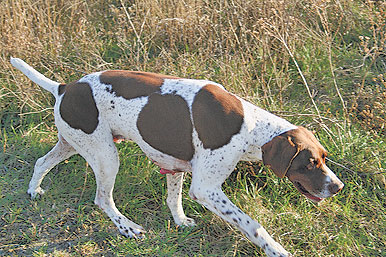
Typical Braque Francais coloration and pattern. The chocolate brown color is a standard. So is the regal head.
First impression: The Braques accepted my little Brittany into the clan without a snarl or growl. Maybe it was clear that Savvy was boss.
Boisen’s Braques had been through the bird-finding drill. The ringnecks had seen some pressure, had their track shoes on, and were difficult to pin. But the Braques did their job exceptionally well.
“Savvy hunts just a little bigger,” Boisen explained, as we walked a grassy creekbottom. “But Cleo stays closer. It’s a good combination. You hit the ground just a little farther out, and you cover the close-in nooks and crannies you might otherwise miss.”
Savvy worked at an ideal pointer range. He ate up some country, but not too much. Cleo hunted close enough that a flushed bird would present a good shot — something to allow when hunting with clients who are more focused on shooting their birds than on good dog work.
One morning along a slough in a freshly-cut cornfield, Savvy and Cleo made five finds in as many minutes. They nailed the birds with staunch, beautiful points, several of which saw Savvy locked in with head low to the ground and butt up high, Cleo honoring, or vice-versa.
RETRIEVING
Not all pointing breeds like to retrieve. Braques are different. “Braques are natural born retrievers,” Boisen says. “They just do it. It’s a part of their make-up. Encourage and reward it, and they’ll never forget their lessons.”
Not all pointing breeds like to retrieve. Braques are different. “Braques are natural born retrievers,” Boisen says. “They just do it. It’s a part of their make-up. Encourage and reward it, and they’ll never forget their lessons.”
Boisen doesn’t require his Braques to be steady to shot. Why? “Wild pheasants are a different business,” he says. “Here, you need a dog that is going to be moving as you shoot, ready to run down a winged rooster. Not every client thinks that’s slick. But they haven’t dealt with a tough old Dakota ringneck.”
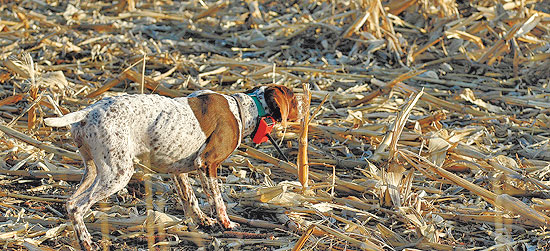 On our hunt, one winged pheasant landed in a cut cornfield and took off. Brad lined up the wind in his Braques’ faces, and they took off. Ten minutes later, Boisen’s 6-foot 5-inch frame and two happy dogs legged it back across the corn stubble from over a half-mile away. Savvy chased, caught and brought that very much alive rooster to hand.
On our hunt, one winged pheasant landed in a cut cornfield and took off. Brad lined up the wind in his Braques’ faces, and they took off. Ten minutes later, Boisen’s 6-foot 5-inch frame and two happy dogs legged it back across the corn stubble from over a half-mile away. Savvy chased, caught and brought that very much alive rooster to hand.
The Braques’ water work was also impressive. I have always refrained from shooting pheasants over water. After I held back once, Boisen advised, “Just shoot the birds. These dogs will not hesitate to go in.”
When my boy Ethan dropped a rooster in the middle of a stock pond, the Braques dived in with glee. “They absolutely love the water,” Boisen laughed as I marveled at something my own dear little dog wouldn’t do.
Which brings up a good point. If you’re primarily an upland hunter but like to mix in some ducks, the Braque makes a perfect choice. “They’re great in a blind, nice and calm,” Boisen describes. “My buddy in Wisconsin has one of my Braques. It made 16 successful retrieves on 17 downed ducks last fall.” That’s a fine performance.
The only drawback to the Braque as duck dog might be a limit on late-season toughness. Braques are perfect for early season teal and wood ducks, even mid-season mallards. But the dog’s coat wouldn’t manage an icy-cold late diver hunt. Mid- to late-November is pheasant time anyway!
VERSATILITY
Braques are good in more places than the pheasant fields. Michel Gelinas uses his Braques primarily for woodcock. “My friend in upstate New York had his Braques pointing and holding ruffed grouse at five months,” says Boisen. “Braques are great on sharptails, too,” he adds, “learning to point early before getting too close and busting the covey.
Braques are good in more places than the pheasant fields. Michel Gelinas uses his Braques primarily for woodcock. “My friend in upstate New York had his Braques pointing and holding ruffed grouse at five months,” says Boisen. “Braques are great on sharptails, too,” he adds, “learning to point early before getting too close and busting the covey.
“I have Braques in Oregon and Idaho,” he continues, “used on chukars, sage grouse and blue grouse.” It is quite clear that the Braque adapts easily to a variety of home habitats and birds, “and they travel well and learn new game quickly,” Boisen concludes.
TRAINING
A dog’s traits are part of its recipe for success. Good training is the other critical aspect of the recipe.
A dog’s traits are part of its recipe for success. Good training is the other critical aspect of the recipe.
The Braque needs a soft touch. “They come mostly trained,” says Boisen with pride. “Natural hunting, pointing and retrieving instincts are there. All you have to do is encourage them. But guide everything gently, softly and positively. These dogs do not respond well to harsh approaches.”
This means no hollering or loud noises. Use cautious, progressive, low-impact techniques for introducing gun sounds. Focus on positive reinforcement. Put a Braque in an environment where it can get experience and develop its natural hunting, pointing and retrieving instincts, and you will have a fine hunting companion.
CONCLUSION
It was entertaining to hear Boisen’s occasional French-language commands for his dogs — apporter (fetch), s’asseoir (sit) and venir (come) as we hunted. I imagined some canine ancestor of Savvy, Cleo, Perle or Vin on the flanks of the Pyrenees — maybe pointing a flock of partridge — and smiled.
It was entertaining to hear Boisen’s occasional French-language commands for his dogs — apporter (fetch), s’asseoir (sit) and venir (come) as we hunted. I imagined some canine ancestor of Savvy, Cleo, Perle or Vin on the flanks of the Pyrenees — maybe pointing a flock of partridge — and smiled.
The dogs didn’t care where they were. And they looked as beautiful and at-home on the South Dakota prairie as I’m sure they did in the grain fields and pastures of their origin.
For More Information
If you’re interested in the Braque Francais you can check out Braques, along with updates on litters and pups, at the Chenil de Grand Ciel (Big Sky Kennel) web site, www.braquefrancais.org.
If you’re interested in the Braque Francais you can check out Braques, along with updates on litters and pups, at the Chenil de Grand Ciel (Big Sky Kennel) web site, www.braquefrancais.org.
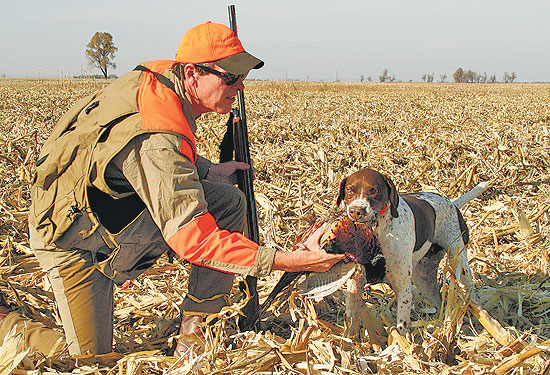
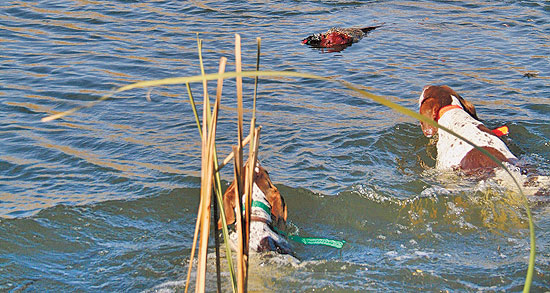
No comments:
Post a Comment